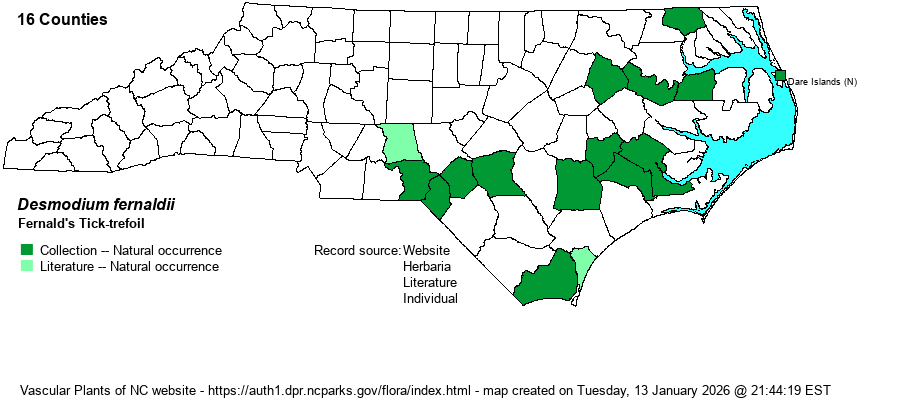| Author | Schubert | |
| Distribution | Widely scattered over the Coastal Plain, but poorly known; specimen records for just 14 counties, and a few other photos and sightings.
This is mostly a Coastal Plain species, ranging from DE and northern VA south to northern FL and LA. | |
| Abundance | Seemingly rare and probably overlooked, but this is speculative; in fact, in VA, it is simply called "infrequent" as opposed to "rare". Is it really more "common" in VA than in NC? Few people seem to be familiar with it in NC, and most of the NCNHP's 16 records are historical, perhaps suggesting a lack of interest in relocating it. The four other records it has in the database are "extant", again a sign of lack of interest in persons going back to known sites and gathering information. This agency lists it as Signficantly Rare, but as an S1 State Status. However, the editors suggest a rank of S2?, at least for now. | |
| Habitat | This species favors dry and typically sandy soil, of pine/oak sandhills and the drier portions of pine flatwoods. It also can be found in sandy openings and edges and other disturbed but dry or sandy places. The species has probably declined in recent decades, owing to fire suppression of its often piney habitats, but this is only speculation. |
| Phenology | Blooms from June to September, and fruits from August to October. | |
| Identification | This is a fairly typical Desmodium species, growing erect to about 2-3 feet tall. It has a hairy stem, with numerous uncinate (hooked) hairs, and such hairs are also present on the leaf petioles and the stalks of inflorescences. The 3 leaflets are fairly large and ovate to triangular in shape, with the terminal being quite large, at about 3.5-4 inches long, with nearly straight sides tapering to the apex. The leaflets are mostly glabrous, but below they have distinctive uncinate hairs on the veins, a key field mark. The long panicles are terminal and axillary, with numerous pink to purplish flowers, each about 1/3-inch long. This will be a tricky species for people to identify in the field, but look for a Desmodium with fairly large leaflets and the terminal one rather triangular. Then check to see if it has uncinate hairs on the veins below, as well as on the stems; you may well need a hand lens to check these hairs. Considering that records come from all parts of the Coastal Plain, there still should be quite a few populations waiting to be discovered. | |
| Taxonomic Comments | None
| |
| Other Common Name(s) | None | |
| State Rank | S1 [S2?] | |
| Global Rank | G4 | |
| State Status | SR-P | |
| US Status | | |
| USACE-agcp | | |
| USACE-emp | | |

